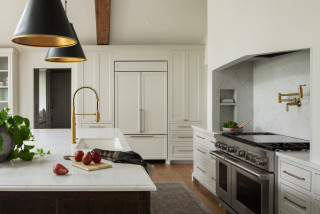
This article was originally published by a www.houzz.com . Read the Original article here. .

This article was originally published by a www.houzz.com . Read the Original article here. .

Where would you like your shower to stand? A corner is the most common spot, but the center of a room or a separate enclosed area like a water closet might be best for your layout or lifestyle.
Keep in mind that moving or adding plumbing costs money, sometimes a lot of money. So if that’s not in your budget, try to keep your updated shower in the same location as your previous one.
If you’re wondering how much space you’ll need, consider that the most popular shower widths are 32, 36 and 60 inches. (Lengths will vary.) Shower dimensions can be as small as 32 by 32 inches, but most people prefer a shower that’s at least 36 by 48 inches. Shower ceiling heights typically fall between 84 and 120 inches, depending on the space and the design.
You’ll also want to consider the dimensions of other elements in your bathroom before deciding on your shower size. For example, the size of your planned vanity might require a reduced shower space, so you might want to consider going for a smaller vanity to get a larger shower.
Another thing to consider is increasing the size of your bathroom to get the shower size you want. Talk with your design pro about opportunities to steal space from an adjacent closet or bedroom or even whether relocating the bathroom to another room in the house is the best move.
Find a bathroom designer near you
This article was originally published by a www.houzz.com . Read the Original article here. .

Keeping your email accounts as clutter-free as possible may improve your productivity and efficiency. Also, a continuous stream of unwanted emails can camouflage and push down important emails that are actually relevant and need your attention.
Take steps to stop the sources of spam and junk emails rather than merely deleting them. You can start by unsubscribing from legitimate company emails that you didn’t sign up for or no longer want. If you’re unsure of a sender’s legitimacy, opt to mark the email as spam and block the sender to prevent future communication.
You may also receive excess emails from senders you like or need, such as retail email marketing, magazine or news subscriptions or shipping confirmations. You won’t want to unsubscribe from these emails but you may want to delete outdated ones.
To streamline the process, focus on one sender at a time. For example, search for the newsletter you subscribe to. If you have accrued many in your inbox, you may be able to select them all, perhaps with the exception of the latest edition, and delete them en masse. Deleting by sender may save you time by not having to sort through various unrelated emails and deciding one by one.
This article was originally published by a www.houzz.com . Read the Original article here. .

Designer: Maritza Capiro
Location: Coral Gables, Florida
Size: 189 square feet (18 square meters)
Homeowners’ request. “The homeowners wanted a functional yet stylish home office that could seamlessly blend into the overall design aesthetic of their home,” designer Maritza Capiro says. “The previous space lacked warmth, cohesion and efficient storage, which made it feel more utilitarian than inviting. They wanted a workspace that felt luxurious, inspiring and uncluttered — a place where they could focus while also enjoying the beauty of their surroundings. To address these needs, we focused on creating a layout that balanced functionality with visual interest. By adding custom built-ins, intentional lighting and an eye-catching desk, we transformed the space into a statement-making office that supports productivity and relaxation.”
Special features. “The sculptural, curved desk serves as a centerpiece, combining artistry with practicality,” Capiro says. “Its soft, neutral finish complements the room’s light, airy palette while standing out as a design focal point. The black built-in shelves provide ample storage for books and decorative objects, while the arched detail adds architectural interest. The matte black finish contrasts beautifully with the lighter elements in the room. The statement chandelier adds texture and sophistication to the space, while a picture light over the shelves enhances the display. The light wood flooring grounds the space and adds warmth, while layered textures such as the area rug, upholstered chair and patterned accent chair create a welcoming and polished look. The walls are painted in a soft, neutral tone (Extra White by Sherwin-Williams) that enhances the natural light and makes the room feel spacious.”
Cord and document control. “To keep the space visually clean and organized, we included hidden storage within the built-ins and desk,” Capiro says. “Cords are discreetly routed behind the furniture, while the desk drawers store necessary office supplies and documents. This strategy keeps everything functional but out of sight, maintaining the overall polished look.”
Designer tip. “Invest in a statement desk that doubles as both a functional piece and a design focal point,” Capiro says. “Pair it with custom built-ins to ensure all storage needs are met without cluttering the room. Additionally, layering textures through rugs, upholstery and accents can make any space feel more inviting and cohesive.”
Shop for home office furniture
This article was originally published by a www.houzz.com . Read the Original article here. .

“We are frequently considering how things will work in 20 years’ time and all that’s in between,” says designer Steve Root of Roots Kitchens, Bedrooms and Bathrooms. “That means thinking about how the homeowners’ needs might change, how lifestyles may develop, how things will wear and break and, thus, how they can be maintained.”
But that doesn’t means a kitchen without character. Because when form and function work hand in hand, you’re winning at design.
This article was originally published by a www.houzz.com . Read the Original article here. .

Food magazines may tell a different story, but striving for perfection on Thanksgiving is only bound to stress you out. Before your holiday planning begins in earnest, take a moment to discard too-high expectations, and focus instead on what a happy Thanksgiving Day would really look and feel like to you.
To me, it involves a messy kitchen, tried-and-true dishes, loud and boisterous good times with family, shared thanks, an afternoon walk in the fallen leaves, and someone pitching in to help with the dishes. Think of your own top-five favorite things about Thanksgiving and be sure to include them in your celebration.
Your Guide to Stress-Free Thanksgiving Prep
This article was originally published by a www.houzz.com . Read the Original article here. .

Because holiday schedules can be all over the map, trying to coordinate a project installation at this time of year can be a challenge. In fact, it can be such a challenge than many pros suggest avoiding installations altogether and waiting until the new year to schedule them.
“A lot of our installers and subcontractors are also taking off for the holidays,” says Rebecca Sutton of Kitchen Design Concepts in Dallas. “We have conversations with our clients during the sales process — if their project timeline runs over the holidays, we know to begin their project at the start of the new year.”
Ruchi Agrawal Mohan of DesignbyRuchi in New York agrees that project installations during the holidays are a hassle. “It’s always harder to schedule deliveries and installations during the holidays,” she says. “The buildings are shut down for deliveries, clients are hosting and vendors are not available. I try to put installations on the schedule way ahead of time or after the holidays have passed.”
Stephanie Frees of Plain & Posh in Clarendon Hills, Illinois, also tries to avoid holiday installations. “I have always tried to get projects completed by Thanksgiving,” she says. “No one wants workers in their homes when they are trying to decorate for the holidays and then hosting holiday events.”
How to Create an Engaging End-of-Year Newsletter
This article was originally published by a www.houzz.com . Read the Original article here. .

In most kitchens, the dishwasher is conveniently located next to the sink to simplify loading. When laying out your space, also think about the ease of unloading clean dishes and flatware. Consider where you’ll be standing when the dishwasher door is open and how easily you’ll be able to access drawers and storage.
Since emptying the dishwasher is a frequent task, convenient access to storage should be a priority. I have seen several kitchens where an open dishwasher door blocks access to storage for dinnerware and flatware. Other kitchen layouts require walking across the room to put away dishes. Also make sure there’s plenty of space to stand at the sink when loading the dishwasher.
This article was originally published by a www.houzz.com . Read the Original article here. .
There’s a reason “location, location, location” has become one of the most-used real estate phrases of all time. When it comes down to it, in many situations, location sells. People in the market for luxury homes often seek one out in scenic areas.
Location can help a property stand out. But in popular resort communities, many homes on the market can claim to have a great location. Many people wonder how they can give their property a leg-up on the competition, so Summit County real estate experts offered a handful of tactics people looking to sell their luxury property can deploy when the competition is also pointing to its backyard and the mountain views in the High Country.
Many local real estate agents emphasized the importance of maximizing curb appeal when vying for bids in a resort-town market.
Dana Cottrell, a Realtor for the Summit Resort Group and president-elect of the Colorado Association of Realtors, said curb appeal becomes more paramount based on the price of the home. She said the more expensive the property is, the higher the expectation is that it will have strong curb appeal.
That means investing in smart landscaping decisions as you own the home, and, when you’re ready to sell, Cottrell said curb appeal also means getting rid of any weeds in the front lawn or driveway, ensuring the lawn looks well-kept and highlighting the property’s tasteful landscaping.
Jim Schlegel, a branch broker with Slifer Smith & Frampton Real Estate’s Ten Mile Team, said outdoor amenities — such as pools or fireplaces — can also help enhance curb appeal. A property that’s set up in a way that facilitates large gatherings or parties is likely going to stand out compared to others on the market.
Cottrell and Schlegel said in an era where many people rely on the internet to scope the scene for what luxury homes are on the market, it’s also very important to evoke good curb appeal in a property’s listing online. They said the best way to do that is to get aerial drone footage of the property so people can get insight into it — and its surroundings — before visiting it in person.
Cottrell said that high-quality aerial drone footage is becoming a standard in the luxury home market — so much so that some buyers are starting to expect it.
High-quality visuals are important tools to both show off the uniqueness of a property and its interior. It can be the difference between someone opting to tour a home — or not.
“A buyer could be from anywhere from London to Mexico City. … Being able to present that property fully and show it off and make it enticing is important because it can get somebody to hop on a plane from London to come see it,” Schlegel said.
Schlegel generally instructs photographers photographing homes he is selling to show how different aspects of the home function through the still images. For instance, he asks the photographers to have the faucet on when photographing the bathroom, and he wants the fireplace to be all lit up when capturing the living room.
He added it’s crucial to showcase all the amenities that make the home unique in a listing, especially if the unit can be categorized as a ski-on, ski-off property, which he said are generally the fastest selling in Summit County.
Cottrell said it’s imperative to showcase the home while it’s at its prime in a listing, which is largely dependent on making sure the home looks spotless. She said even a small smudge on a bathroom mirror can impact how buyers view a home.
Alongside ensuring that every window sill looks dustless and every counter appears immaculate, it also means taking out anything like family photos before staging a home and offering tours.
“The whole idea is you want a buyer to be able to envision themselves living there,” Cottrell said. “Having family photos on the wall can make that hard to do.”
While selling a luxury home can be tough in a market where “great locations” are everywhere, Cottrell said its useful for the seller to have patience. Luxury homes tend to stay on the market longer, so people interested in eventually selling should keep this in mind.
Editor’s note: This story originally published in the June/July Summit County Home magazine.
This article was originally published by a www.summitdaily.com . Read the Original article here. .
Knowledge is power. Knowing what kind of stain you are dealing with will determine the best course of action. Here’s how to attack some of the most common rug and carpet stains.
Coffee, tea, cola. One of the CRI’s most recommended methods for cleaning a variety of stains begins with a combination of one-quarter teaspoon of liquid dishwashing detergent with 1 cup of lukewarm water. According to the experts, although you may be tempted to add more dish soap, don’t do it. The less soapy residue you have to rinse out at the end, the better.
To create the solution, use a mild dish soap, never a laundry detergent or an automatic dishwashing detergent, since those often contain optical brighteners or bleaching agents, which can harm carpet dyes and fibers.
If the stain is stubborn, follow the dish soap solution with a mixture of 1 cup of white vinegar per 2 cups of water. The CRI says that since white vinegar is a 5 percent acetic acid solution, it acts as a solvent that will work on both the stain and the dish soap residue.
Finally, when it’s time to rinse the area, the institute advises using lukewarm tap water in a spray bottle.This precaution is aimed at avoiding oversaturating the carpet and harming the layers beneath. Blot with paper towels and pat dry after each rinse. Several rinses may be necessary to thoroughly eliminate the residue.